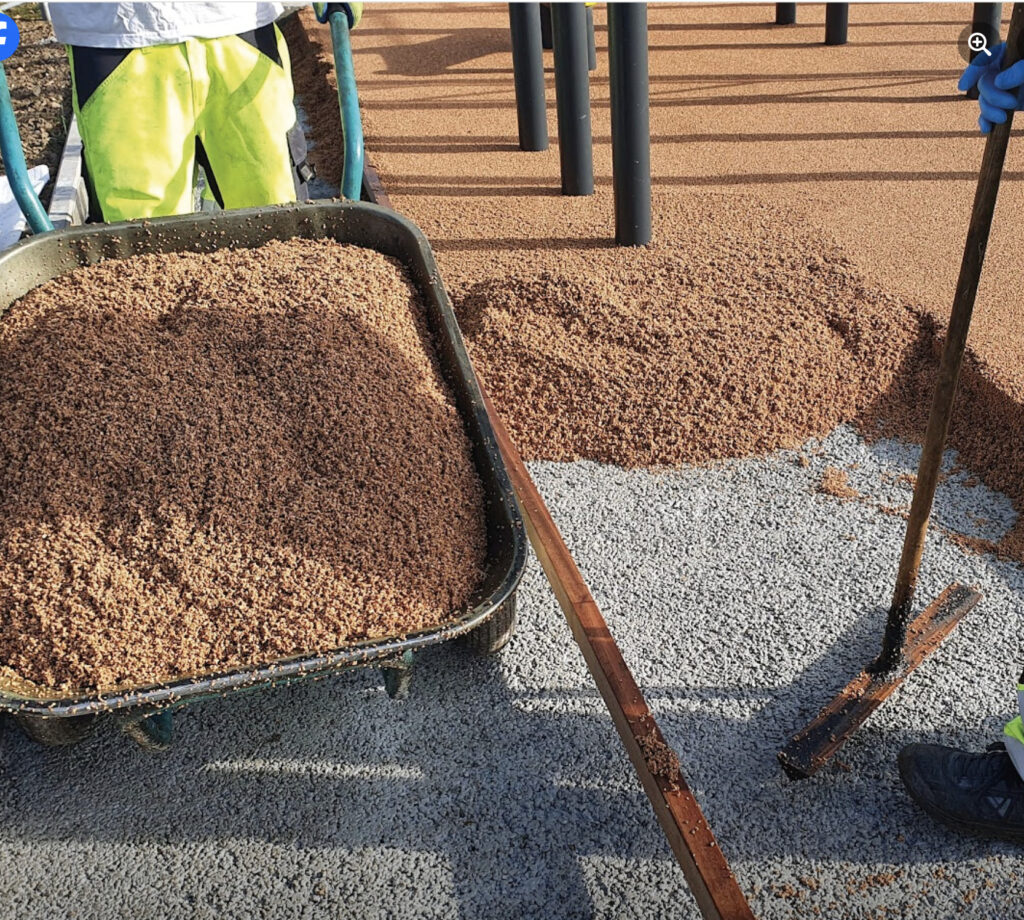Amherst Board of Health Advises Against Crumb Rubber Products for New School

Corkeen, an alternative to poured in place rubber. Photo: Corkeen / Facebook
Amherst Board of Health recommended at its meeting on February 8, 2024, that the playground surface at the new elementary school at the Fort River school site avoid the use of products that contain crumb rubber (granulated particles of waste tires).
The Board was asked to offer its assessment about the planned use of rubber Poured In Place (PIP) for the playground surface at the new school. In its recent permitting decision for the new school, the Amherst Conservation Commission specifically omitted approval for the proposed rubber playground surface because of the risks it poses to the environment. The Commission asked the school designers to seek safer alternatives and to come back to it for final permitting. Margaret Wood, Owner’s Project Manager for the school project, had reported to the Board of Health and Conservation Commission that the designers (DiNisco) were actively investigating the use of Corkeen for the playground surface, a product that is relatively new to the North American market but has been used widely in Europe, including in colder Scandinavian climates. Corkeen is made using cork rather than crumb rubber, and produces a similarly-smooth, unitary surface that is fully ADA accessible and meets fall safety standards for playgrounds.
Amherst Public Health Director Kiko Malin reported that since the Board of Health last discussed this issue, she had spoken with the experts who had produced the Toxic Use Reduction Institute’s (TURI) report on playground surfacing, Rachel Massey and Lindsay Pollard. The TURI report recommends wood or cork products as safer alternatives to synthetic products made with or without waste tires.
Board of Health member Timothy Randhir (UMass professor on Environmental Conservation), summarized the research on crumb rubber products. He noted that crumb rubber, which is manufactured from recycled tires, contains multiple toxic substances including heavy metals, volatile and semivolatile organic compounds, and polyaromatic hydrocarbons that are released into the environment from products that contain this substance. He noted that “people are using it (crumb rubber) but also there’s concern and the science is catching up with a lot of studies emerging”. As a local example, rubber PIP was installed recently at Groff and Kendrick parks before these concerns came to the fore.
The Board’s discussion focused on the public health implications of the use of rubber PIP containing crumb rubber. The motion, which was approved unanimously, was similar to a 2023 recommendation by the Board of Health to avoid the installation of artificial turf at the high school because of its risks to humans and the environment. The motion language was as follows:
“Under Massachusetts General Law, the Amherst Board of Health has the responsibility for the protection of the public’s health and the protection of the environment from damage and pollution. Following the precautionary principle of public health that states that a product, an action or a policy has a suspected risk of causing harm to the public or to the environment, protective action should be supported before there is complete scientific proof of risk. The Board advises that the new school building committee avoid or limit the use of materials that contain heavy metals, polyaromatic hydrocarbons, microplastics, or other components known to be harmful to children and the environment in the playground surface. These chemicals are known to be found in recycled tires. Therefore, the AmherstBoard of Health does not support the use of crumb rubber derived from recycledtires in the construction of the new playground at this time.”
The choice about which material to use on the playground surface will be made by the Elementary School Building Committee and will then be brought back to the Amherst Conservation Commission for permitting approval.

It’s refreshing to see Town boards such as the Board of Health and the Conservation Commission act independently and make decisions based on science and data. Now if only the powers that be would listen and heed the advice. Corkeen appears to be a viable, more environmentally-friendly alternative to rubber PIP. It will be cooler than rubber PIP on hot days, won’t shed lead into our children, and won’t leach toxic chemicals into our waterways. The decision seems like a relatively easy one to me. I hope the School Building Committee will buck the trend and select the safer alternative for the playground surface at the new Net Zero Fort River school.
Thank you board of health for weighing in. Crumb rubber is toxic. Not what we need in a $100,000,000 school especially if we’re paying top dollar, which make no mistake we are.